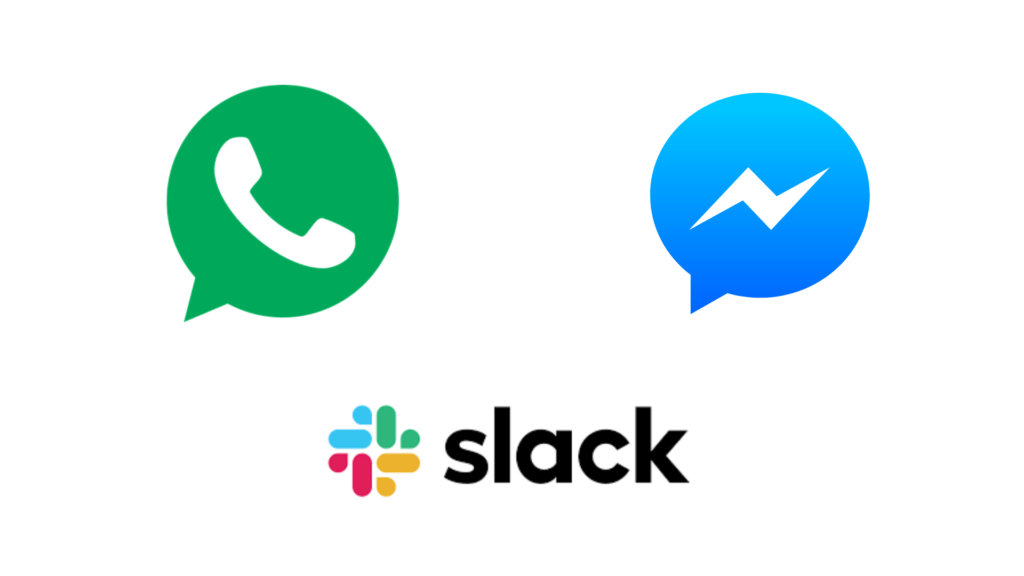Why Choose Mern to Build Real-Time Chat App
November 9, 2022
In this article, we’ll show you how to create a real-time chat application using the MERN stack.💡
Introduction
Users frequently favor chat or instant messaging apps over traditional means of communication. Because chat is asynchronous, it lacks the burden and haste of a phone call yet still feels quicker and less professional than email. In July 2021, about 2 billion users were accessing WhatsApp messenger monthly. Due to their widespread use and popularity, chat platforms are attracting the attention of new businesses and app developers, who are now looking for information on how to create them for websites and mobile apps.
Your search ends with this post, as we have covered all the needed aspects of a real-time messaging app and why you should choose the MERN stack development services.
Leading Chat App Example
The market for chat apps is overwhelming. Due to their inability to deliver scalable, reliable performance with a captivating user experience, the majority of new messaging apps fail. Before prioritizing features, making technological choices, or allocating technical expertise, teams intending to introduce a new product into this competitive industry require a thorough grasp of the qualities and flaws of their rivals. Do a careful analysis of the strengths and weaknesses of the best chat apps listed below and yield insightful information to guide the creation of your chat app.

Features:
- End-to-end encryption (E2EE)
- Starred Messages
- Groups (channels) with customized notifications for up to 256 users
- messages in text, photos, videos, and audio
- Calls using voice and video via the internet
- Sharing pictures directly from the built-in camera app or from the device’s storage
- File sharing up to 100MB for PDFs, documents, spreadsheets, and presentations
- Enable online payment
Facebook Messenger
Features
- Optional two-factor authentication (2FA) and end-to-end encryption (E2EE)
- Customizable reactions with any emoji, message effects, and selfie stickers
- Users can select their UI themes and colors.
- Group video call “rooms”
- Facebook, WhatsApp, Instagram, and Portal integrations
- Push notifications are optional
- Threaded comments
- Device fingerprint authentication is optional.
- Possibility of sending friends Instagram messages from Messenger
Slack
Features:
- Channels, direct messaging, and group messaging
- Support for multiple integrations with third-party apps
- Commands in slash
- Discussion threads
- Reactions
- Mentions
- Attached documents
- Calling via audio and video
- Conversational AI Slackbot
- Automated recollections
- Messages pinned
- Messages saved
Real-time chat apps are currently designed with a variety of capabilities, and their features and functionalities are what determine their growth and success in the market. Now, let us look at some of the most popular features you can incorporate into your real-time chat app.
What Are The Must-have Features?
Group and One-On-One Chat
With the help of added facilities like emojis, a file uploading option, phone contacts, etc., one-on-one and group chat lets you rapidly connect via text message with a specific member or a group of users at a time to make conversation faster.
Encrypted Communications
Any chatting app’s primary challenge is security. The interaction between you and other people is completely secure due to end-to-end encryption. Here, the information is encrypted at the sender’s end and is automatically decoded at the receiver’s end, providing the highest level of security against intruders.
Multiple Media Support (File and Image)
Aside from chat, voice, and video, real-time messaging also uses multimedia tools like animation, GIFs, and photos. Sending others visuals, GIFs, photos, and emojis to convey your feelings enables you to have more dynamic and enjoyable conversations.
Video Conferencing and Video Calling

It is impossible to imagine a real-time chat app without video calling and video conferencing capabilities. This is the case since these capabilities enable you to rapidly engage in one-on-one or group video chat interactions with a large range of worldwide people, regardless of where they are located.
We’ve discussed the essential features of a real-time chat app. Next, let’s talk about its technical aspects.
Robust Real-Time Chat App Technical Stack
Have you ever noticed how flawless these real-time chat apps are in terms of their features? The technical stack, ultimately, is what matters. Yes! The one who quietly works and offers the finest assistance in developing the best real-time chat platform. Let’s look at a few tech stack variations to gain a clear picture.
The frameworks, protocols, infrastructure, and front-end and back-end coding languages you select should align with the objectives and skill levels of your team. The relevant frameworks and tools can simplify some processes by employing pre-built objects to tackle common issues rather than requiring lower-level programming. And that’s when using a full stack like MERN will save you a lot of effort, time, and money.
But Why MERN Stack?
First, let’s understand what the MERN stack consists of before we get into the whys.
MongoDB
You’ll need a database that’s just as straightforward as React, Express, and Node if your app saves any data (user profiles, content, comments, uploads, events, etc.).
JSON documents written by your React.js front end can be sent to the Express.js server for processing, and (if they are valid) they can then be immediately saved in MongoDB.
ExpressJS
Express.js, which functions inside a Node.js server, is the lowermost level. Express.js is exactly what it says it is: a “fast, unopinionated, straightforward web framework for Node.js.” Strong models for managing HTTP requests, replies, and URL routing are provided by Express.js (mapping an incoming URL to a server function).
Sending XML HTTP Queries (XHRs), GET requests, or POST requests from your React.js front end allows you to link to the Express.js functions that power your application. These functions make use of the Node.js drivers for MongoDB to access and alter the data in the MongoDB database.
ReactJS
The top layer of the MERN stack is made up of React.js, a declarative JavaScript library for creating dynamic client-side apps in HTML. Simple components can be linked to data on your back-end server using React, and complex interfaces can be linked to those connections and rendered as HTML.
It includes good support for forms, error handling, events, lists, and more—everything you’d want from a modern web framework. With little effort and code, React excels at handling stateful, data-driven interfaces.
NodeJS
It is a cross-platform framework for creating mobile apps, and the back end uses an open-source JavaScript runtime environment. A V8 engine called Node.js runs JS code outside of a web application. Node.js can be used to create original content for websites, gather form data, change database data, and manage server files, among other things.
Node.js does not create new threads for each request; instead, it only runs one process at a time. To prevent JS code from being stuck, it also contains a set of I/O primitives.
Reasons to Pick Mern for the Chat App
Reusable Code
The components of a web application made with MERN technology can be changed and reused. The quickest turnaround for your product is guaranteed thanks to this reusable component, authorized for production use.
High Scalability and Compatibility With the Cloud
Things are constantly being posted to all platforms, therefore there is no chance that scalability will be compromised. The MERN stack also includes Node.js, which maximizes processing power, and MongoDB, a NoSQL database that is extremely scalable and compatible with cloud storage. As a result, the data gathered from the platforms may be easily managed from any location in the world.
Frontend Customization Reduces Complexity
The PHP-based LAMP architecture mostly uses backend coding and offers a static user experience because of the significant HTML content and server-side scripting. On the other side, the MERN stack’s Model View Controller (MVC) design enables an unrestricted level of platform frontend customization. Instead of managing the material via backend panels, you can change your user interface to give your users a unique experience.
Real-Time Interaction
The fact that this tech stack operates in real-time, i.e., notifications, updates, etc., are made immediately without the need to wait for the website to refresh, is a salient feature. Particularly for social media or e-commerce apps, this is very useful.
Flexible Alterations
Testing and updating codes are relatively easier because all scripts and components are hosted on a cloud platform. With the reduction of development and testing periods, application modifications are made quickly.
With No Licenses
Most open-source platforms only charge nominal license fees. MERN has no licensing restrictions despite being an entirely open JavaScript stack. Additionally, they are rather fast accessible through libraries and public repositories.
Only Uses One Language
The MERN stack simplifies communication between the client and server by utilizing only one language, namely Javascript. Additionally, it eases the additional burden of mastering many frameworks and languages. Developers who are proficient in Javascript can work with this tech stack with ease.
1. What Makes MERN Stack So Popular?
The MERN stack’s popularity may be attributed to its adaptability, one-language design, use of one of the most well-liked libraries in the world (React), and resource efficiency.
2. Can I Use the Mern Stack for App Development?
Yes, you definitely can! Modern enterprises can develop and implement apps thanks to the MERN stack. Additionally, MERN uses JavaScript to facilitate and accelerate the development of full-stack web applications.
3. Why Is Mern Stack a Preferable Platform for Startup Apps?
The MERN stack is favored because it offers entire project development capabilities for managing and creating web apps. The MERN stack requires the least amount of investment when developing apps, and it also saves you time and effort because one developer can handle both front-end and back-end development tasks with it.
Final Note💡
This brings us to the conclusion of our post, where we briefly touched on the requirements for creating a chat app before turning our attention to MERN’s popularity and how it supports the development of a real-time messaging app. It is clear that MERN stack development is here to stay, and the ability it offers to create scalable and reliable applications may prove to be quite helpful. All you need to do is hire a full-stack developer, which can greatly expand your business options, allow you the chance to work with cutting-edge technology, and increase your revenue. As a result, it must be integrated with our services and used to provide the greatest goods for your businesses.
Check out more : Best Web Scraping Services
Recent Post
Recommended Blogs
Let’s Discuss your Ideas.
Contact usJoin our Team
Go to CareerOur Offices
INDIA
B 401-402, Shilp Corporate Park, Rajpath Rangoli Rd, Thaltej, Ahmedabad, Gujarat 380054
CANADA
1932 50 Ave SW,Calgary, AB T2T 2W2, Canada
Hire a Team
NextJS DeveloperVueJS DeveloperAngularJS DeveloperReactJS DeveloperNodeJS DeveloperKotlin DeveloperPython DeveloperMEAN Stack DeveloperRuby on Rails DeveloperFlutter Developer© 2025 ultroNeous. All Rights Reserved.